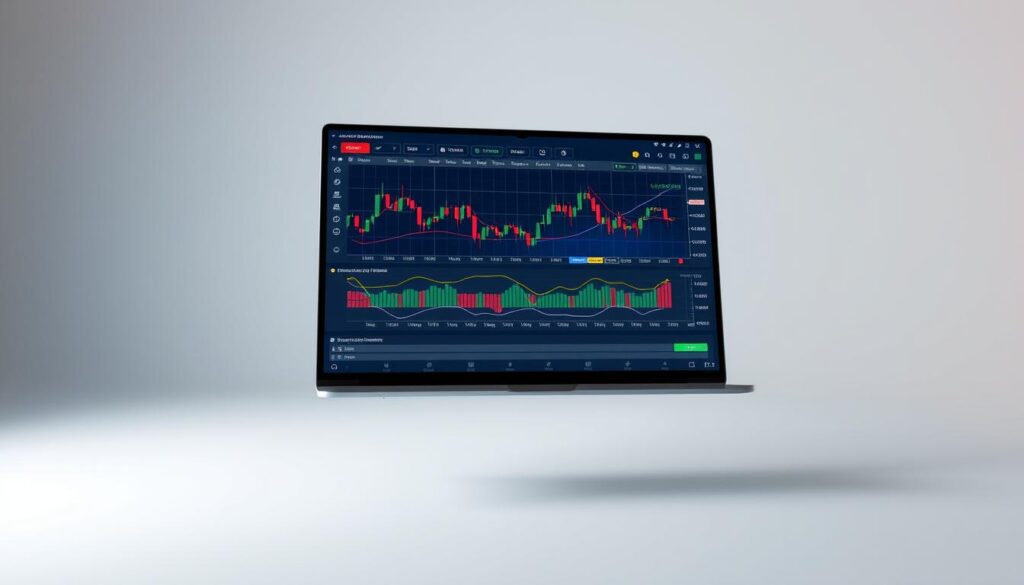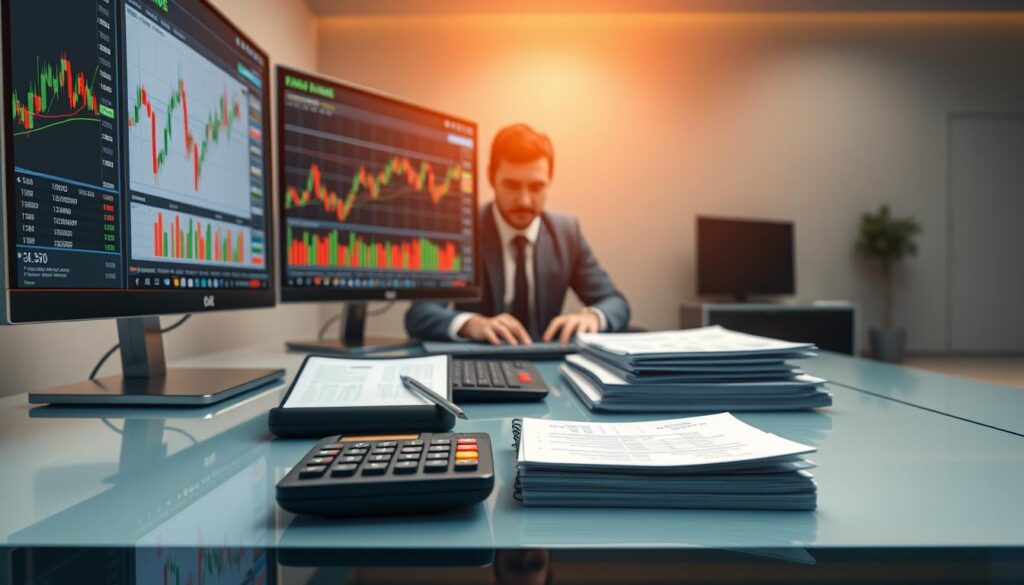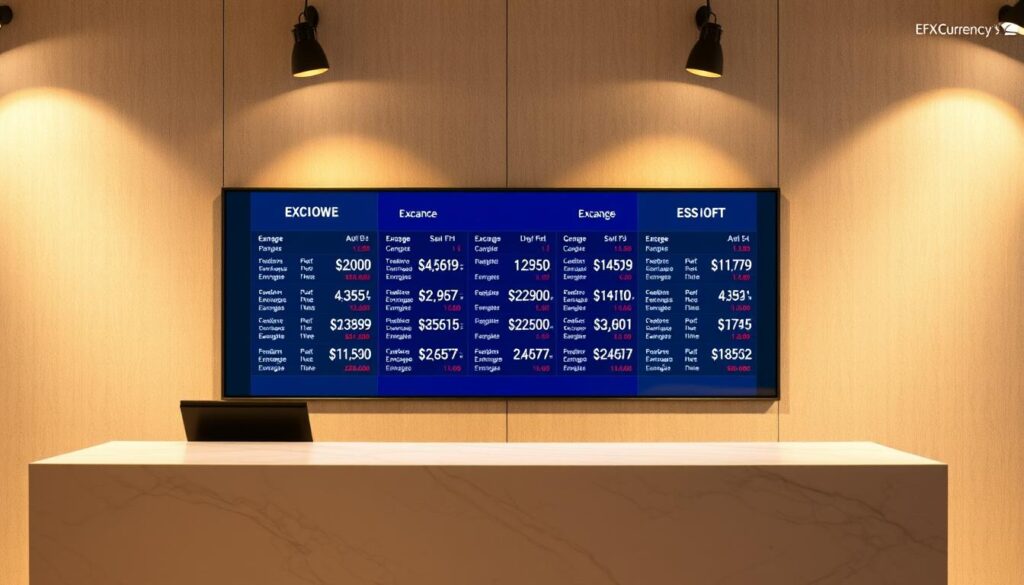The forex market is huge, with $7.5 trillion traded daily. It’s open 24/5, making it great for those wanting to start trading. But, is $100 enough to begin?
Online platforms have made trading forex easy. They help students learn with little money. But, it’s important to know the risks. For example, a $100 deposit could lose 88% from a big move.
Demo accounts are great for beginners. They let you practice without losing money. This article aims to help new traders understand the market.
Introduction to Forex Trading for Students
Currency pairs are key in international money deals. The forex market buys and sells these pairs, like EUR/USD. Each pair shows how much one currency is worth in another.
Prices move in tiny steps called pips. Major pairs like EUR/USD are most traded. Minor and exotic pairs offer more chances. Knowing these is key for new traders.
What is Forex Trading?
Forex trading is exchanging one currency for another to make money from rate changes. Unlike stock markets, it’s open 24/7, five days a week. This is perfect for students with busy lives.
Why Forex Trading Appeals to Students
It’s easy to start with little money. Mobile apps let you trade anywhere. This fits well with a student’s life.
It also offers a chance to make money from home. But, young traders need to be careful. Learning and practicing are key to success.
Can You Start Forex Trading With $100?

A $100 deposit might seem small, but it can open doors. With the right plan and knowledge, even a small budget can help. But, it’s important to have realistic goals and a solid plan.
The Feasibility of Trading With a Small Budget
Micro lot trading lets beginners start with little money. For example, 0.01 lots are 1,000 units of a pair. This means a $6,000 position can start with just $60 in margin with 1:100 leverage.
Here’s how it works:
- 5 micro lots = $6,000 notional value.
- Margin is 1% of the total position, which is $60.
- Brokers offer different leverage ratios, from 1:50 to 1:1000.
This makes trading easy, but it also increases risk. A 176-pip loss could lose 88% of a $100 deposit. This shows the need for caution.
Understanding Margin and Leverage
Margin is the money needed to start a trade. Leverage makes your trading power bigger. For example, a 1:100 ratio lets you control $10,000 with just $100. But, it also means bigger losses.
Things to think about include:
- Stop-out levels, where positions close if margin falls below 20%.
- Swap fees, which can hurt small accounts over time.
- Avoiding Martingale strategies, as they can quickly use up your money.
Even with risks, some traders make a 10% monthly return. The secret is to balance big dreams with careful risk management.
Setting Up Your Forex Trading Account

Starting in financial markets means setting up a safe account. You need to pick a good broker, know the platform, and practice with a demo account. This guide helps beginners start safely and know what they’re doing.
Choosing the Right Broker
Finding a broker is very important. Beginners should look for regulated platforms, like those in the UK. IG and CMC Markets are good choices because of their low spreads and clear rules.
Things to consider:
- Spreads: Compare 0.1 pips vs. 1.5 pips for EUR/USD.
- Margin call policies: Know how brokers handle account deficits.
- Platform options: Look at MetaTrader 4 versus web-based platforms.
Stay away from unregulated offshore brokers. They might not be safe or fair.
Opening a Demo Account
A demo account is a great tool for beginners. It lets you practice with fake funds, like LiteFinance’s $100 simulation, without losing real money. It helps you get used to the trading platform and feel more confident.
Benefits of demo accounts:
- Learn platform features and tools.
- Test strategies without risk.
- See how demo trading is different from real trading.
To start, you need to verify your identity with documents like a passport and proof of address. This makes sure you follow the rules.
Understanding Forex Market Basics

Knowing how currencies work is key to financial markets. Currency pairs, like GBP/USD or EUR/USD, show the exchange rate between two currencies. For example, if GBP/USD is 1.2800, £1 is worth $1.28. This price shows how the two currencies relate.
The market is open 24 hours a day, with big trading times in London, New York, and Tokyo. Each time has different levels of activity, with the London-NY overlap being the busiest. This global setup means there’s always a chance to trade.
Currency Pairs and Exchange Rates
Currency pairs are divided into major, minor, and exotic. Major pairs, like EUR/USD, are the most traded because they’re very liquid. The exchange rate shows the difference in value between two currencies. For example, if EUR/USD is 1.20000, €1 is worth $1.20.
Central banks play a big role in changing these rates. For instance, the Bank of Japan might step in to keep the JPY stable. Their actions can cause short-term changes, affecting price movements.
How the Forex Market Operates
The interbank market is where big banks trade currencies. Retail traders use brokers and platforms like MetaTrader to get in on this. The Asian session is less volatile than the London-NY overlap.
A pip is the smallest price movement, usually 0.0001. For example, in a 100,000 units lot, one pip is $10. Knowing this helps traders figure out profits or losses.
There are two main trading methods: spot and forward contracts. Spot contracts settle right away, while forward contracts are for later. Rollover interest affects overnight positions, based on interest rate differences.
The market uses two main models: market makers and ECNs. Market makers set their own prices. ECNs connect buyers and sellers directly. Each model has its own benefits, depending on the trader’s strategy.
Essential Forex Trading Strategies for Beginners
Understanding effective strategies is key in financial markets. Beginners should start with methods that fit their time and risk level. Scalping and swing trading are two popular methods.
Scalping and Day Trading
Scalping aims for quick, small profits, targeting 5-10 pips per trade. It uses 15-minute charts and fast action. For example, a 5-pip gain on 5 micro lots is $2.50.
Day trading involves opening and closing positions in one day. Both strategies need discipline and a good grasp of technical analysis. Tools like moving averages help find good times to trade. But, beginners should watch out for high-frequency trading risks.
Swing Trading Strategies
Swing trading is good for those with less time. It aims for 50-100 pip movements over days or weeks. Aligning trades with economic events can boost success. A 1:3 risk/reward ratio is often suggested to maximize gains while limiting losses.
Testing strategies on volatile pairs like GBP/USD can give insights. Mixing manual and algorithmic approaches can also improve results. By learning these methods, beginners can build a solid and profitable position in the market.
Risk Management in Forex Trading

Keeping your capital safe is vital for long-term success. Without good risk management, small mistakes can cause big losses. This section covers ways to protect your investments and keep your finances stable.
Setting Stop-Loss and Take-Profit Orders
Stop-loss orders protect traders from big losses. They close a position if the market moves against it. For example, a stop-loss at 20 pips on a $100 account limits losses to $10 per trade.
Take-profit orders lock in gains when the market moves in favor. Using both tools helps balance trading. Traders can also use trailing stops to secure profits while managing risks.
Managing Your Trading Capital
The 2% risk rule is a good strategy. It means risking no more than 2% of your capital on a single trade. For a $100 account, this means a $2 maximum loss per trade. Position sizing formulas can help keep trades consistent.
Emotional control is also key. Many traders make impulsive decisions, like overtrading or ignoring stop-loss levels. Sticking to a plan helps avoid these mistakes.
Regularly withdrawing profits is also wise. It locks in gains and prevents impulsive reinvestments. By using these strategies, traders can protect their funds and build a lasting trading plan.
Calculating Margin and Leverage

Learning about margin and leverage is key to managing funds well. These ideas help control risks and increase possible gains. Knowing how to calculate them is vital for making smart choices.
How to Calculate Required Margin
The formula for margin is simple: Margin = (Lot Size × Contract Size × Price) / Leverage. For instance, trading 0.1 lot of EUR/USD at 1.1200 with 1:30 leverage needs a $37.33 margin. This formula helps figure out how much money is needed to start a trade.
Brokers set different margin needs. For example, a $6,000 position might need $60 at 1% margin. It’s also important to know about cross margin accounts. These let you use funds for different positions.
Understanding Leverage Ratios
Leverage boosts trading power but also ups the risk. A 1:100 ratio means you control $10,000 with just $100. But, higher ratios like 1:500 can lead to big losses if not managed right.
ESMA rules limit retail traders to 30:1 leverage for major currency pairs. This rule helps protect traders from too much risk. For example, a $100 account with 1:30 leverage can open a $3,000 position. But going over this limit can lead to a margin call.
Margin calls happen when (Equity/Used Margin)×100% falls below a broker’s limit, often 20%. Keeping an eye on margin levels is key to avoid sudden position closures. By mastering these calculations, traders can confidently navigate financial markets.
Practical Steps to Start Trading
Starting in financial markets means knowing how to deposit funds and place trades. This section offers a clear guide for beginners to start with confidence.
Depositing Funds into Your Account
Before you can trade, you need to fund your account. FCA-compliant brokers offer safe deposit methods like debit cards and bank transfers. These options ensure your money is safe and follow rules.
There might be fees for currency conversion if your account is in a different currency. For example, putting £100 into a USD account might cost a bit. Always check your broker’s fees to avoid surprises.
Start with a $100 deposit to start trading. This amount is enough for small positions and keeps risk low. Once your deposit is in, you can explore the trading platform.
Placing Your First Trade
MetaTrader 4 is a top platform for trades. Start by opening the order window and picking your currency pair, like EUR/USD. You can choose a market order, which happens right away, or a limit order, which waits for a specific price.
Transaction costs include the spread and any commissions. For example, a 1.5-pip spread on EUR/USD means you pay $1.50 per 0.1 lot. Slippage, or price changes during execution, can happen during big news events.
After your trade, you’ll get a confirmation email and access to post-trade analytics. It’s wise to keep a journal of your first 10 trades. This helps track your progress and find areas to get better.
Analyzing the Forex Market
Good market analysis uses both technical and fundamental methods. Understanding these helps make smart choices and spot chances. This section looks at tools and strategies for beginners.
Technical Analysis Basics
Technical analysis looks at past price movements to guess future trends. Tools like RSI, MACD, and Bollinger Bands are used. For example, RSI divergence signals can show when a market might change direction.
Here are some steps to use technical analysis:
- Draw support and resistance levels on a GBP/USD daily chart.
- Backtest moving average strategies on EUR/JPY to find patterns.
- Use Bollinger Bands to see volatility and spot breakouts.
Fundamental Analysis for Forex
Fundamental analysis looks at economic factors that affect price changes. Important indicators include CPI data, interest rate decisions, and employment reports. For example, a high CPI can make the USD stronger because of inflation.
Practical uses of fundamental analysis include:
- Looking at how Fed interest rate decisions affect USD pairs.
- Comparing COT reports with retail sentiment to see market direction.
- Studying NFP releases to understand volatility patterns.
Combining both analysis types helps in navigating the market better.
Common Mistakes to Avoid in Forex Trading
Many new traders make common mistakes that can cause big losses. Knowing these traps can help beginners keep their capital safe and build a good strategy. This section talks about two big areas: overtrading and ignoring risk management.
Overtrading and Emotional Decisions
Overtrading is a big problem, mainly for beginners. It often comes from emotional choices, like revenge trading after losing. For example, after three failed trades, a trader might bet more to win back, leading to bigger losses.
Here are some emotional pitfalls:
- Revenge trading: Betting more after losses can lead to deeper losses.
- Confirmation bias: Ignoring signals that go against what you expect.
- FOMO: Chasing breakouts without proper analysis leads to bad entries.
Being disciplined is key. Keeping a trading journal can help spot patterns and improve decision-making.
Ignoring Risk Management
Ignoring risk management is another big mistake. For example, risking 20% of a $100 account on one trade can lead to an 88% loss from a 176-pip move. This shows why setting stop-loss orders and following the 2% risk rule are important.
Other common mistakes include:
- Slippage: During high-volatility events, prices can change a lot before you can trade.
- Swap fees: Not considering overnight costs in carry trades can eat away at profits.
- Correlation neglect: Trading multiple EUR pairs without thinking about their relationship.
By avoiding these mistakes, traders can protect their capital and have a better chance of success.
Building a Forex Trading Plan
Making a solid plan is key to success in financial markets. Without a clear plan, even the best opportunities can lead to confusion and losses. A good trading strategy helps stay focused, manage risk, and reach long-term goals.
Setting Realistic Goals
Starting with achievable goals is key. For example, aiming for a 10% monthly return is better than 100% yearly. This mix of hope and reality helps grow your money safely.
Here’s how to set SMART goals:
- Specific: Pick a specific currency pair or market session.
- Measurable: Use a trading journal to track your progress.
- Achievable: Make sure your goals fit your capital and time.
- Relevant: Your goals should meet your financial needs.
- Time-bound: Set deadlines for your goals.
Developing a Consistent Strategy
Being consistent is vital for success. A good trading strategy has clear rules and risk plans. Testing it with past data, like 2020’s market, shows its strengths and weaknesses.
Steps to a consistent strategy:
- Plan your time well to balance trading and life.
- Focus on a few currency pairs to know them better.
- Use weekends to plan for the week.
- Keep a journal of your emotions during trades.
- Review your progress monthly and adjust your strategy.
By taking these steps, you can create a strong plan. It will match your personality and financial goals, leading to lasting profits.



